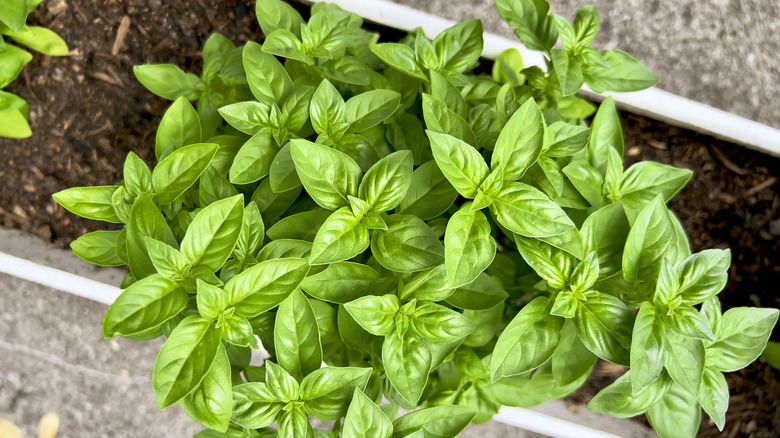The One Spot You Should Always Cut To Keep Basil Thriving
Cutting a flourishing plant back in order to maintain its health can feel counterproductive. After all, bigger is better, right? Well, to coax a basil plant toward bigger and better, regular trimming is absolutely essential. Pruning will encourage your plant to grow plenty of leaves bearing the sweetest, most basil-y flavors. However, singling out the best spot to make the cut is essential.
As long as your plant is 6 inches tall or larger, harvest your basil from just above the node, which is a pair of leaves. New leaves should appear at that spot in about a week. Do this every two to three weeks, and this fast-growing herb should respond by creating more branches with an abundance of luscious new leaves. The best part of this is the handful of fresh basil to enjoy a couple of times per month.
Snipping away at your basil plant frequently keeps it from bolting and wasting energy producing flowers and seeds. Trims help the plant put all of its effort into growing bushy and bursting with aromatic leaves. This practice also improves air circulation and can stave off pests and diseases.
Best practices for basil pruning
Trimming your basil to keep it from bolting is key to a maximum yield, and there's a simple trick for gauging exactly where to make the cut. Once you notice signs that your basil plant is about to flower, start at the soil, and count up three pairs of leaves along the main stem. Give it a snip right above the third pair. Even if you don't see the startings of a flower, trimming the plant is still beneficial.
While this is a great trick for young, small plants, you'll need a critical eye to know if this technique is right for your situation. Without the right care, you can over-prune your basil, and that's one of the biggest mistakes to avoid. Be sure not to snip away more than ⅓ of the plant. In general, aim for trimming the uppermost portion of the plant, right above a node.
However, counting up three nodes from the soil line doesn't work as brilliantly on plants you've already pruned. You can follow a version of this trick by counting up two or three nodes from where you initially pruned the plant and cut there.
